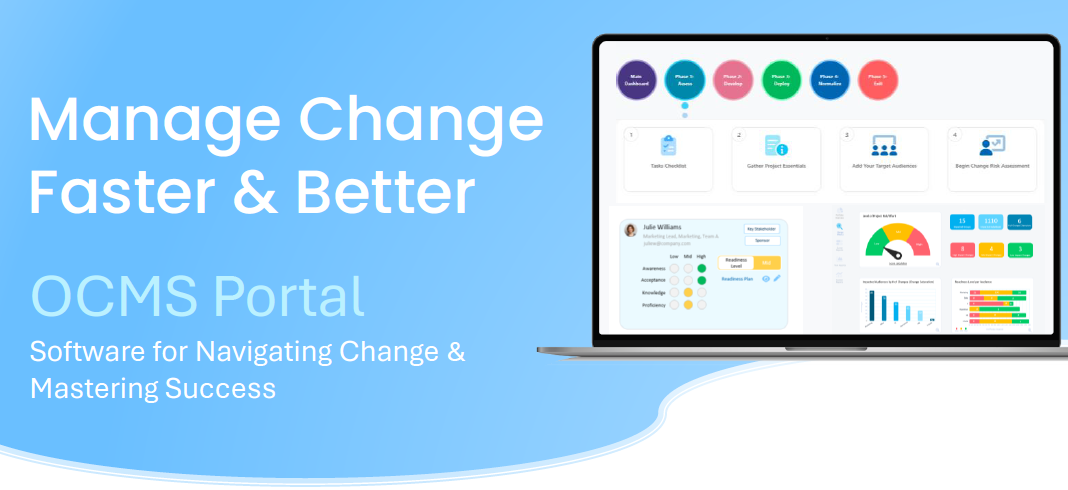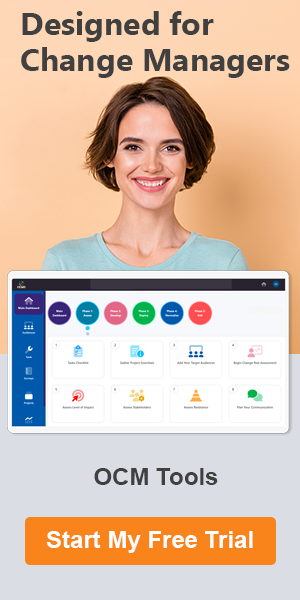The Best Strategies for Managing Change in Organizational Development
The business landscape is ever changing. New technologies emerge, customer expectations shift, and companies need to change to adapt. In this ever-evolving change environment, it’s sink or swim.
Organizations that prioritize organizational change and development are poised for success. But navigating change effectively can be a complex dance.
Watch a summary below:
Story Highlights
|
Organization development, the process of leading organizational change…
This blog post delves into the world of OD and change, equipping you with 7 powerful strategies to lead your organization through positive and sustainable transformations.

What Is Change in Organizational Development?
Organizational change and development are two sides of the same coin.
- Change management focuses on the practical implementation of alterations within an organization. It’s the “how” of transformation, ensuring a smooth transition from the current state to the desired future.
- Organizational development, on the other hand, takes a broader view. It’s the “why” and “what” behind change, focusing on developing the long-term capabilities and culture needed for continuous adaptation. Think of it as cultivating fertile ground where change can flourish.
Organizational change and organizational development are a potent combination. By strategically integrating both approaches, organizations create a framework for not only surviving change but thriving in its wake.
7 Strategies for Mastering Organizational Development and Change Management (OD&C)
Now that we understand the melody, let’s explore the instruments that will help you orchestrate successful change through organizational development and change management.
Summary of the seven organisational change development strategies:
- Diagnose: Conducting a Needs Assessment for organizational development change management
- Cultivate Champions: Building a strong support system for change and organisational development
- Communication is Key: Keeping everyone informed and engaged as part of OD and change
- Invest in Your People: Bridge the skills gap to encourage sustained change
- Celebrate Wins (Big and Small): Recognizing and rewarding progress as part of change in organizational development
- Embrace Feedback and Iteration: Continuous learning to support organisational change development
- Lead by Example: Setting the tone for positive change in organizational development from the top
Do you have any questions or feedback about organizational change and development? We’d love to hear from you. Reach out here.
Now, let’s take a deeper look into each of the strategies for mastering organizational change and organizational development.
1. Diagnose: Conducting a Needs Assessment
Before embarking on any change initiative, it’s crucial to understand your organization’s current state. This involves conducting a thorough needs assessment. This assessment should identify:
- Strengths and weaknesses: Evaluate your organization’s existing capabilities, processes, and culture.
- Gaps and opportunities: Pinpoint the areas where change is needed to achieve your strategic objectives.
- Employee sentiment: Assess your employees’ attitudes towards change, their current skill sets, and potential resistance points.
The needs assessment provides a roadmap for your change initiatives. This organizational development change management step gives leadership vital information on how to prioritize these initiatives for the biggest benefit to the organization. It ensures you’re addressing the right challenges and sets realistic goals for the transformation journey.
2. Cultivate Champions: Building a Strong Support System
Change, by its very nature, can be disruptive. To navigate these disruptions effectively, you need a dedicated team of change champions. These champions can be leaders at various levels, influential employees, or even cross-functional teams.
The role of a change champion is to:
- Communicate the rationale and benefits of the change to their colleagues.
- Address concerns and answer questions.
- Lead by example and demonstrate their own commitment to the change.
- Provide ongoing support to help colleagues navigate the transition.
By building a network of change champions, you create a strong support system that fosters a sense of ownership and accountability for the change initiative. During OD and change initiatives, this network becomes the change manager’s eyes and ears and helps them keep a pulsebeat on employee sentiment and other factors that can contribute to project failure or success.
3. Communication is Key: Keeping Everyone Informed and Engaged
Open and transparent communication is the lifeblood of successful change. Employees need to understand the “why” behind the change, how it will impact them, and what the expected outcomes are.
Effective communication strategies include:
- Regular town hall meetings with clear and consistent messaging.
- Open communication channels such as company intranets, Q&A sessions, and feedback mechanisms.
- Targeted communications tailored to different employee groups or departments.
Remember, communication isn’t a one-way street. Actively listen to employee feedback, address concerns promptly, and celebrate milestones along the way. This fosters trust and keeps everyone engaged in the change process. A solid communication strategy is a cornerstone of change and organisational development.

4. Invest in Your People: Bridge the Skills Gap
Change often necessitates new skills and capabilities. To ensure a smooth transition, invest in your employees’ development. This could include:
- Training programs focused on the specific skills needed for the change initiative.
- Mentorship and coaching programs to provide ongoing support and guidance.
- Opportunities for cross-training to broaden skill sets and build adaptability.
Investing in your people as part of organizational development, the process of leading organizational change demonstrates your commitment to their success. Comprehensive training based on a training needs analysis helps them adapt to the changing landscape and keeps an organization resilient. When employees feel equipped and supported, they’re more likely to embrace change with a positive attitude.
5. Celebrate Wins (Big and Small): Recognizing and Rewarding Progress
Change can be a long and arduous journey. Recognizing and celebrating milestones along the way is crucial for maintaining momentum and motivation.
Here’s how to create a culture of recognition:
- Publicly acknowledge achievements and contributions towards the change effort.
- Implement incentive programs that reward successful implementation of new processes or skills.
- Create a culture of positive reinforcement where employees feel valued for their efforts.
Celebrating progress, big or small, creates a positive feedback loop. It reinforces desired behaviors and encourages continued commitment to the change initiative.
Would you like to receive content related to organizational development and change management? Sign up for our monthly newsletter filled with OCM tips and knowledge.
6. Embrace Feedback and Iteration: Continuous Learning
Change initiatives rarely unfold exactly as planned. Unexpected challenges and roadblocks are inevitable. This is where continuous learning becomes a crucial component of organizational change and organizational development.
Here’s how to foster a culture of learning and adaptation:
- Establish feedback mechanisms like change readiness surveys, focus groups, and one-on-one conversations to gather employee feedback on the change process.
- Analyze the feedback to identify areas for improvement and adjust your approach as needed.
- Encourage experimentation and pilot programs to test new ideas and approaches before full-scale implementation.
By embracing feedback and adapting your strategy based on learnings, you demonstrate flexibility and a commitment to continual improvement. This fosters a culture of agility, allowing your organization to respond effectively to unforeseen challenges.
7. Lead by Example: Setting the Tone from the Top
Successful organizational change and development starts at the top. Leaders play a critical role in setting the tone, vision, and direction for the change initiative.
Here’s how leaders can champion OD and change:
- Demonstrate a clear and unwavering commitment to the change initiative.
- Walk the talk by embodying the desired behaviors and values associated with the change.
- Empower employees to take ownership and contribute to the change process.
- Be visible and accessible to address concerns, answer questions, and provide ongoing support.
Leaders who lead by example set the standard for the entire organization. Their unwavering commitment and proactive approach create an environment where change is embraced as an opportunity for growth and advancement.
The Final Note: Mastering the Art of Change
Organizational change and development is a continuous process, not a one-time event. By integrating these seven powerful strategies, you can equip your organization with the tools and mindset to navigate change effectively and emerge stronger on the other side. Remember, successful change is about more than just implementing new processes; it’s about cultivating a culture of adaptability and continuous learning.
So, embrace the challenge, empower your people, and watch your organization blossom in the ever-evolving landscape of business.
Need Great Software to Support Organizational Development Change Management?
OCMS Portal by OCM Solution is an all-in-one change management solution. It’s easy to use and walks teams through a comprehensive process. OCMS Portal is designed to help you deploy effective change management to support change in organizational development for any size company.
Learn more and sign up for a free trial today!
FAQ – Change in Organizational Development
Organizational change and development are two sides of the same coin. Change management focuses on the practical implementation of alterations within an organization. Organizational development focuses on developing the long-term capabilities and culture needed for continuous adaptation.
Change management is the “people” side of change. It’s about enabling impacted individuals and groups to change successfully in support of a company initiative.
Management of change in organizational development is vital to ensuring a transformation succeeds. Projects often fail due to a lack of user adoption. Change management helps ensure user adoption succeeds and is sustainable.What is organizational change and development?
What is change management in OD?
Why is change management in organizational development important?
Note: Content on OCM Solution's ocmsolution.com website is protected by copyright. Should you have any questions or comments regarding this OCM Solutions page, please reach out to Ogbe Airiodion (Change Management Lead) or the OCM Solutions Team today. OCM Solution was previously known as Airiodion Global Services (AGS).
External Sources: stock.adobe.com




